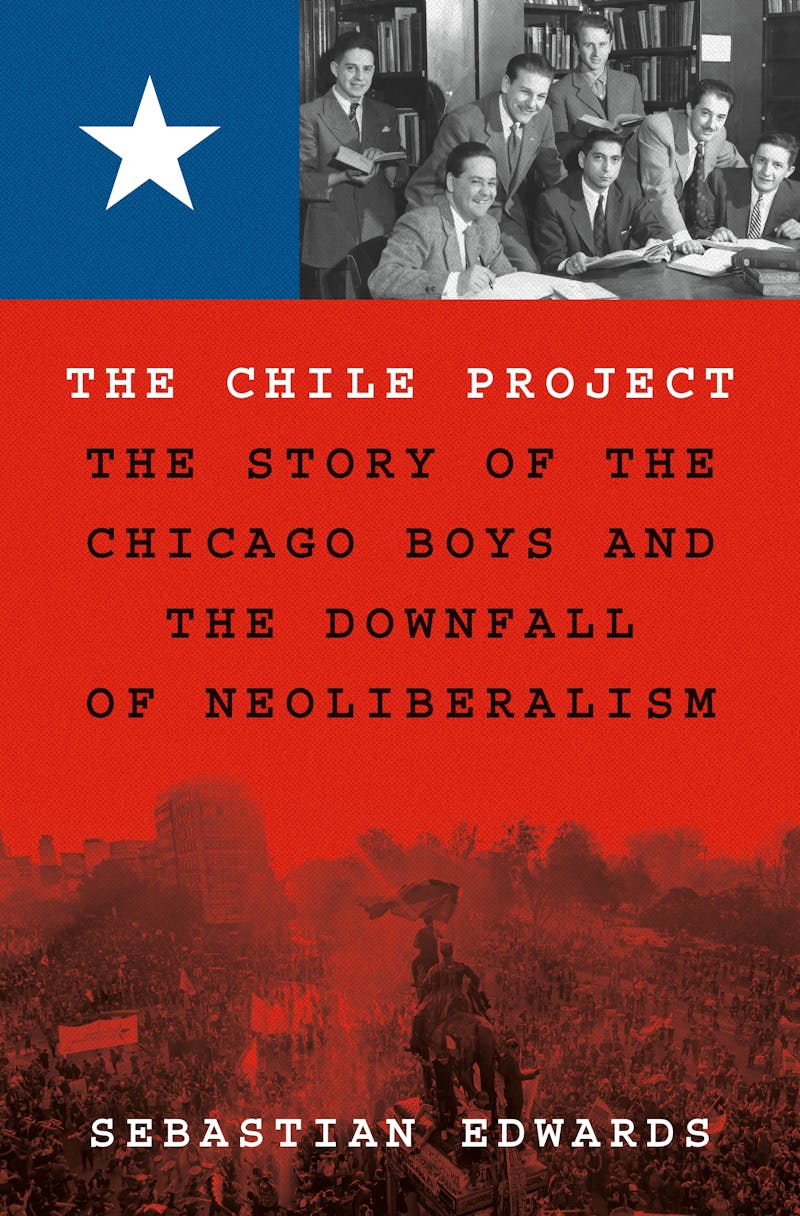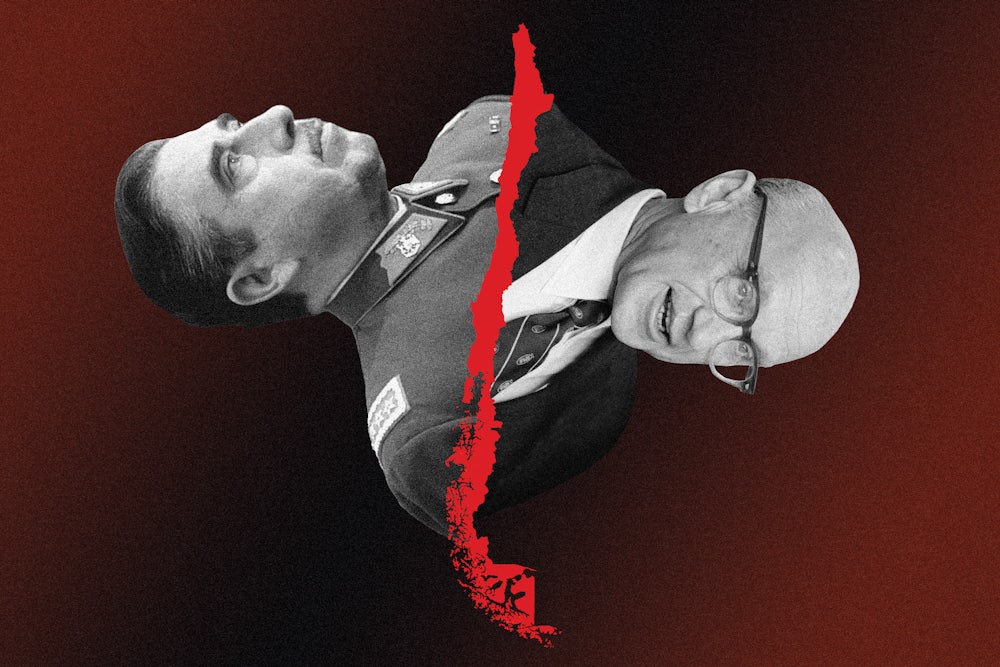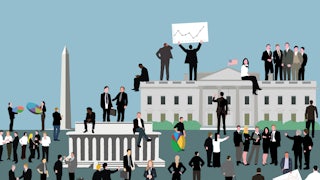It began underground. In October 2019, high school students led protests in the city of Santiago, spurred by an increase in public transit fares. They began to jump the turnstiles, and soon more and more people joined them. Chile’s carabineros used tear gas to expel people from the subway stations. Soon, the city—and the country—were in revolt. Millions protested peacefully, and sometimes the atmosphere was joyful. Musicians played and crowds sang the anthem of the Popular Unity government that had been removed in a coup d’état in 1973: “El pueblo unido, jamás será vencido: The people, united, will never be defeated.” But there was also tension: Barricades went up, stores were looted, metro stations burned, and young people dismantled streets with chisels to throw cobblestones at police.
Above ground, in their modern high-rises, the greatest beneficiaries of Chile’s economic growth were shocked. The country, by many metrics, seemed to be doing well. It is one of only four in Latin America to have joined the Organization for Economic Cooperation and Development, the club of “developed” countries. Its GDP per capita has risen from the middle range of Latin American countries to among the very highest. Its poverty rate, over 60 percent in 1987, had declined to 8 percent, and inequality (though still very high) had fallen, too. But the country’s history has given its market economy a sinister undercurrent.

In 1970, the Socialist Salvador Allende was elected president, promising a democratic and legal path to socialism—Chilean-style, a socialism “with red wine and empanadas.” Three years later, he was ousted by a military coup. The dictatorship led by Augusto Pinochet murdered and exiled many of its opponents—and worked to remake the relationship between state, economy, and society. To do the latter, it followed the advice of a group of economists known as the “Chicago Boys,” for most of them had trained at the University of Chicago, where their teachers included Milton Friedman (who became the most famous) and his colleague Al Harberger (who cared most about Chilean development). But Chicago’s economics department was not just any program. Its tendency was to trust markets and to mistrust regulation. The Chicago Boys extended the reach of market logic as deeply as they could: slashing state employment, dismantling unions, and creating a privatized pension system. By the time the regime left power in 1990, Chile was considered among the most “neoliberal” societies on Earth.
Parts of the Pinochet-era economic policy persist in Chile today, where the left sees them as a poisoned legacy of the dictatorship. Many books on the left—think of Naomi Klein’s The Shock Doctrine, for example—have linked Pinochet’s state terrorism to his Friedmanite libertarian economic program. When Friedman was awarded the Nobel Memorial Prize in Economic Sciences in 1976, during the ceremony a protester heckled, “Freedom for Chile!... Crush capitalism!” On the right, meanwhile, figures such as Joaquín Lavín have celebrated Chile’s market reforms, praising the nation’s “Silent Revolution” for saving the country. When George W. Bush proposed a partial privatization of Social Security in 2005, he was following the Chilean template.
In his account of this economic history, The Chile Project, Sebastian Edwards tries to steer a middle path. He acknowledges errors driven by ideological Friedman-like inflexibility. But he wants to rescue the reputation of the more pragmatic Chicago Boys, like his former teacher Harberger. He attempts to reckon with important mistakes, while still reclaiming Chile’s market economy from the legacy of the dictatorship. His approach, grounded in archival research and economic analysis, is a careful and serious one. Yet the project is far from simple: how to separate the vision of liberation that Pinochet’s authoritarian regime presented from the Chicago ideas of markets as freedom?
In Chile, the Edwards surname is as famous as it gets; a bit like being a Rockefeller in the United States. The family scion, Agustín Edwards Ossandón, a railroad baron and banker, was the richest man in nineteenth-century Chile. His great-great-grandson, Agustín Edwards Eastman, owned and published the conservative newspaper of record, El Mercurio, and, after Allende’s election, lobbied the Nixon administration to remove him. But not everyone in the extended family agreed: Sebastian, who interweaves pieces of his own story through The Chile Project, was a college student at the University of Chile during the Allende years, and a supporter of the government.
Young Edwards did recognize that there were problems under Allende. The first year or so of Allende’s term saw real gains for Chilean workers, producing feelings of abundance that lifted daily worries for Chile’s poor. But in the long run, the administration plotted a doomed course. Nationalizations by government decree and seizures of lands and businesses by workers placed management challenges on the state. Inflation began to increase. Edwards, who worked in a planning office responsible for setting prices, remembers sometimes being told to deliberately lose a file. As requests to increase prices were denied (or misplaced), black markets emerged. Early gains in living standards were lost. The Nixon administration, which had pledged to “make the economy scream,” did what it could to exacerbate the situation, and the CIA sent cash to support the opposition and anti-Allende strike activity. But the basic problems were internal. By 1973, 80 percent of industrial output was in state hands. With conditions worsening, Allende, who had been elected with less than 40 percent of the vote, lacked the political majority and the technical capacity to oversee a transformation to democratic socialism.
The end of the Allende administration was a violent one. The Chilean air force bombed the presidential palace; Allende committed suicide with a gun that had been a gift of Fidel Castro. Many of Allende’s government officials were sent to an island camp in the Antarctic south, where their food would be sometimes mixed with pebbles so that they would break teeth. The new regime conducted sweeps against opponents. Some were killed, some jailed, some tortured. Some were affixed to rails and thrown into the sea. Among those killed and disappeared were Edwards’s friends. He tried to stay out of sight, quietly burning books and documents in his home in those first days.
The dictatorship ended up lasting 17 years, producing a death toll in the thousands and around 200,000 exiles. It also produced a profound change in Chile’s political economy. Across the political spectrum, there had been broad agreement in the 1960s that Chile’s economy was not performing well enough, and that widespread poverty was the result. Revolutionaries on the left wanted a transition to a socialist economy; reformists closer to the center tried to break up large estates and provided state support for communal agriculture. On the authoritarian right, there was clamor for order and discipline. But there was another group that thought the answer was simple: What Chile needed was a free market economy.
Al Harberger, who had been involved with Chile for almost 20 years by that time, put it this way during a visit to the country in 1974. Chile’s traditional political economy was like an old donkey: slow, half-blind, and incapable of carrying much. The “social market economy” he thought should be introduced, by contrast, would be like a new jeep: shiny, strong, fast, and in good condition for all sorts of tasks. With the right kind of economic institutions, Chile could prosper.
The foundations for Chicago’s influence in Chile had been laid almost two decades prior. The Pontifical Catholic University of Chile and the University of Chicago began a series of exchanges in 1956, sending Chicago professors to Chile and Chilean students to Chicago. There was clearly a Cold War logic to the initiative, which was brokered by the U.S. government, and which, documents show, was aimed at “resisting Marxist influences in economic and political institutions.” The economists who embraced it, like Harberger and Theodore Schultz (who pioneered the idea of “human capital”), thought of it as a way of building Chile’s capacity to address its own problems.
But the study of economics at the University of Chicago had a peculiar culture. It prided itself on its rigor, and its firmly pro-market orientation was seen as a holdout in a profession that had largely accepted the mixed economy. Though Harberger and Schultz were pragmatic and approached their work as problem-solving, Friedman was more driven by theory. He was the public face of “Chicago economics,” extolling the practical and moral virtues of unregulated markets in bestselling books and on television.
Though there were a few exceptions, most of the Chicago Boys leaned to the right. They found Allende’s socialism offensive and were eager to get to work after the coup. But they began as just one group among several vying to influence Pinochet, including military officers who preferred to retain a role for the state in development plans, and business groups that preferred the protection offered by high tariffs. Two years into the regime, Chile’s economy was continuing to struggle with high inflation. On a short visit in 1975, Friedman had an audience with Pinochet, and advised him to follow the “Chicago” advice, applying a quick liberalization to which the economy would have to adjust. (Unemployment, it turned out, did not adjust quickly.) By 1976, three Chicago graduates had control of the economy—Sergio de Castro as minister of finance, Pablo Baraona as minister of the economy, and Álvaro Bardón in the Central Bank.
High rates of growth strengthened the hand of the Chicago Boys; de Castro’s authority was such that he was one of the only people who could talk back to Pinochet. By 1978, all but seven of the hundreds of the companies in state hands in 1973 had been reprivatized. But the deepest “neoliberal” phase began in 1979, with reforms that reduced the power of unions, decentralized the school system, and replaced pensions with individual retirement accounts. There were programs to address the needs of people in conditions of extreme poverty, but these were limited and strictly means-tested.
In 1982, however, the shiny jeep of a new Chilean economy drove into a ditch, resulting in a severe economic recession. Critics from the left have blamed this on an underregulated banking sector, the result of Friedmanite orthodoxy. Edwards argues that the mistake was more limited: a fixed exchange rate put in place by de Castro and contrary to the teachings of Friedman himself.
Whatever the case, the response to the crisis caused popular discontent. If Chile had been a democracy, the government would have fallen. De Castro lost his job, and Pinochet brought on new personnel (some of whom had been trained at other elite U.S. universities) who retained the open approach but were more flexible in reaching their goals. From the mid-1980s, Chile began to experience good growth and real reductions in poverty, though average wages in 1989 were still lower than those of 1970, and the income distribution was worse. The aggregate economic record of the dictatorship was not actually very strong, unless it gets credit for necessary restructuring, or the clock starts in the mid-1980s.
The true golden years for Chile’s economy were overseen by the reformist center-left coalition that took power after the return of democracy in the 1990s. They restored labor rights and introduced some new social programs. Still, they retained the market economy, openness to trade, and low tax rates, which for some on the left was a bitter pill to swallow. A competitive and consumerist culture would remain; there would be no return to an economy based in solidarity. An American who ended up working as Allende’s translator returned in 1998, to find that many motorists ticketed for driving while using cell phones were “talking” on wooden replicas, preferring the status to the fine.
Edwards sees the prosperity of the ’90s as the Chile Project “bearing full fruit” “forty years after it was launched.” For Edwards is both anti-Pinochet and himself a graduate of the University of Chicago, where he studied with Harberger. After 1973, any successor government would have moved in a “promarket” direction, and he does not think all of the Chicago Boys’ advice was extreme or unsound. He takes exception to those on the left who see everyone at Chicago as inflexible or politically far to the right. Harberger, for example, accepted a role for the state in developing economies like Chile—but he wanted interventions to be careful and professional.
Edwards rejects some of the right-wing version of the story, too, such as its tendency to downplay Friedman’s involvement with Pinochet. Although Friedman’s personal contacts with Pinochet were few, Edwards argues that his 1975 visit was crucial in convincing Pinochet to empower the Chicago Boys and to apply the “shock treatment” to the Chilean economy. Similarly, Edwards does not find plausible the protestations of some of the Chicago Boys that they knew nothing of Pinochet’s human rights abuses: After all, he observes, they themselves were under surveillance, and both Friedman and Harberger were asked to intercede (and did) on behalf of jailed opposition economists.
Edwards’s effort to recuperate the “Chile Project” for the country’s democratic era is a generous one—probably too generous. It is true that having a functioning economy capable of growth is a social good, and that some attacks on neoliberalism take aim with a blunderbuss and hit too much. But they also do hit real targets. Critics have pointed out that it is not quite correct to describe neoliberalism as “unregulated” capitalism—what is regulated is the ability of politics to shape capitalism. The dictatorship did that work while repressing dissent, allowing a particularly extreme version to be put in place with few protections and regulations, and many Chileans suffered as a result.
One former minister of Pinochet, speaking to the Hoover Institution in 1992, said as much: The economic plan “could be so revolutionary because we had a very authoritarian regime.” And the ties to Chicago economics were entwined with the dictatorship’s project in many ways. Milton Friedman’s PBS specials were, for example, shown on Chilean state television in advance of a referendum of Pinochet’s constitution held in 1980. The idea that capitalism was the highest form of freedom was used by the dictatorship to claim that its authoritarian project was advancing freedom—the freedoms embedded in the market—rather than denying political freedoms. Friedman always thought that he (and Chile) were treated unfairly. But whenever Edwards tried to talk to him about the country, he was evasive. It made him uncomfortable, and it should have.
One reason that Edwards might want to claim Chile’s market economy for the democratic era is that he worries that the social explosion of 2019 has put it under threat. The socialist presidency of Salvador Allende, and the neoliberal dictatorship of Augusto Pinochet, have given Chile a kind of disproportionate symbolic power in global debates about political economy. The world once again watched as the recent protests led to the creation of a Constituent Assembly, dominated by the left, to draft a new Constitution. In December 2021, Chileans elected a 36-year-old former student activist, Gabriel Boric, to be president. The proposed constitution aimed to end the legacy of neoliberalism, and Edwards writes with some regret that he expects this to occur, auguring broader changes around the globe. Though he recognizes that many Chileans feel the system is too unequal, and they live with daily reminders of its unfairness and lack of dignity, he fears that moving away from markets and competition will cause Chile to fall back down the rankings of prosperity in Latin America.
But the proposed constitution was defeated in a national referendum in September 2022, 62 percent to 38 percent. What had seemed like a powerful example of the ability of the left to overcome neoliberalism has instead become a warning. President Boric, currently facing low levels of approval, has admitted that “representing discontent is easier than producing solutions for it,” and that a second attempt to write a new constitution will have to aim to include the ideas of more parts of the political spectrum.
And though Chile’s history is in some ways unique, Chile’s is a common political horizon in a world seeking whatever may follow the neoliberal era. If its experience has something to show the globe once again, it might be as an example of how to build consensus around improvements that generate shared prosperity and economic security. Edwards fears that the benefits of a liberal economic order are not sufficiently appreciated, and regrets that so many who might have defended it quit the field to make private fortunes. But that, I’m afraid, is just the logic of the market at work.
Chile’s new constitution—and similar efforts to rebuild in other countries—can let markets do what they do well, while still responding to the demands for more forms of equality, social inclusion, and ecological protection. The end of neoliberalism can, and should, be something to celebrate.






